16
Prevalence of Learning Disabilities
The chapter begins by reviewing recent estimates of the prevalence of learning disabilities (LDs), followed by trend estimates from the general population. The chapter concludes with a comparison of trends for LD in the Supplement Security Income (SSI) program, in the Medicaid population, and in the subpopulation of children who are enrolled in Medicaid by virtue of being SSI recipients.
ESTIMATES OF LEARNING DISABILITY PREVALENCE AND PREVALENCE TRENDS FROM THE GENERAL POPULATION
The committee identified multiple potential data sources that address the prevalence of and trends for rates of learning disabilities in the United States. From these, we identified two data sets judged (1) to be of the highest quality to examine current prevalence estimates of learning disabilities and (2) to characterize trends over the past decade. We selected the National Survey of Children’s Health (NSCH) and the Early Childhood Longitudinal Study (ECLS) (Cortiella and Horowitz, 2014; Dhuey and Lipscomb, 2009) as the strongest sources of information on current prevalence. For trend data, we selected the Individuals with Disabilities Education Act (IDEA) data and the National Health Interview Survey (NHIS) (Cortiella and Horowitz, 2014; Dhuey and Lipscomb, 2009). It is notable that these four data sources have produced different forms of data, with attending strengths and limitations, discussed in Chapter 2. This includes administrative data on service receipt maintained by individual school departments (IDEA), national surveys based largely upon parent report, both by telephone (NSCH)
and in person (NHIS), and a large longitudinal research project involving direct assessment of children with high-quality research measures (ECLS). While there are certainly limitations with each of these imperfect data sources (e.g., errors in parent reports, differences in awareness and available funds across different school districts, attrition in longitudinal cohorts) we are comforted by the set of results that converge through the use of these multiple data sources, on which we base our conclusions that (1) prevalence estimates for LD in the general population range between 5 and 9 percent and (2) prevalence in the general population does not appear to be rising.
Prevalence of Learning Disabilities
Prevalence Estimates from National Survey of Parents
The purpose of the National Survey of Children’s Health is to estimate the national- and state-level prevalence of a variety of physical, emotional, and behavioral child health indicators. It is a random-digit dialing telephone survey and had sample sizes for 2007 and 2011–2012 of 91,642 and 91,800 children, respectively. The question used in the 2007 and 2011–2012 surveys asked, “Has a doctor, health care provider, teacher, or school official ever told you that your child had a learning disability?” Interviews were conducted with parents or guardians of one child randomly selected from each household. There were several questions that assessed not only parent reports that the child had a learning disability, but also, for those who reported learning disabilities, the severity of and services used for this impairment. (Questions assessing the prevalence of learning disabilities were not included in the 2003 survey.) The estimate for current learning disabilities among children of ages 3–17 years in 2007 was 7.8 percent, with 3.7 percent rated as mild and 4.0 percent rated as moderate or severe (NSCH, 2007a,b). The estimate for learning disabilities in 2011–2012 was 8.0 percent for children of ages 3–17, with 4 percent rated as mild and 4 percent rated as moderate or severe (NSCH, 2012a). The percentage of learning disabilities by severity and race/ethnicity is displayed in Figure 16-1. The percentage of learning disabilities by severity and poverty level is displayed in Figure 16-2. With the exception of an apparent increase in moderate to severe LD in the black non-Hispanic group, there are no race/ethnicity differences. In contrast, there is a clear poverty-related gradient for LD.
Prevalence Based on the Early Childhood Longitudinal Studies
The ECLS consists of three cohorts—the birth cohort (ECLS-B), the kindergarten class 1998–1999 (ECLS-K), and the kindergarten class

FIGURE 16-1 Percentage of children with learning disabilities by severity and race/ethnicity.
SOURCE: NSCH, 2012b.
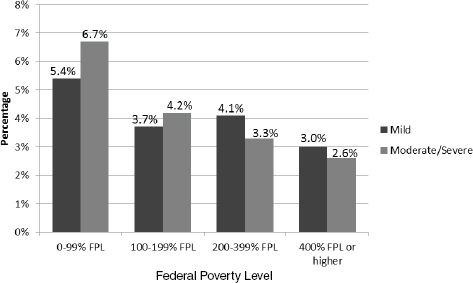
FIGURE 16-2 Percentage of children with learning disabilities by the federal poverty level (FPL).
SOURCE: NSCH, 2012c.
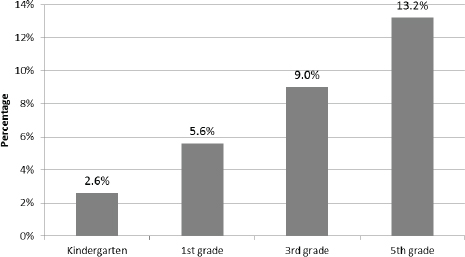
FIGURE 16-3 Ever diagnosed with learning disability: ECLS-K, 1998–2004.
SOURCE: Dhuey and Lipscomb, 2009.
2010–2011 (ECLS-K:2011)—that are used to examine child development, school readiness, and early school experiences (Dhuey and Lipscomb, 2009; Livermore et al., 2011). All three studies have large sample sizes (ECLS-B: 14,000 children; ECLS-K: 21,387; ECLS-K:2011: data collection ongoing) and use several sources of data, including child assessments, interviews, and records (Dhuey and Lipscomb, 2009; Livermore et al., 2011). Results from the ECLS-K indicate that the prevalence of ever being diagnosed with a learning disability increased across the age spectrum from 2.6 percent (kindergarten) to 13.2 percent (5th grade) (see Figure 16-3).
Prevalence Trends
The committee also sought to identify two data sets that would provide the most accurate information on trends in the rates of learning disabilities over recent years. For trend estimates, the committee focused on the IDEA data and the NHIS (Cortiella and Horowitz, 2014; Dhuey and Lipscomb, 2009).
Since 1975, IDEA has provided public access to state-supplied administrative records about children and youths with disabilities up to the age of 21. The data available from IDEA include information on the number and distribution of students served under this law and on the services utilized. Trend estimates for learning disabilities have been measured from 1976 to 2012. As shown in Figure 16-4, from 2004 to 2012, the percentage of
school children identified as having learning disabilities, reported through the IDEA system, decreased steadily from 5.8 percent in 2003–2004 to 4.7 percent in 2011–2012.
The NHIS is the principal source of information on the health of the civilian noninstitutionalized population of the United States. It produces statistical information on the prevalence, distribution, and effects of illness and disability in the United States and on the services rendered because of such conditions. This nationally representative survey has been conducted annually since 1957 and samples approximately 35,000 households containing 87,500 individuals each month (Halfon et al., 2012). From each family in the NHIS, one sample adult and one sample child (if any children are present) are randomly selected, and information on each is collected. Since 1997 the question used in the NHIS for ascertaining LD has been, “Has a representative from the school or a health professional ever told you that [survey child] has a learning disability?” Over the period of interest, from 2004 to 2013, the percent fluctuated between 6.9 and 8.2 percent, with no clear evidence of an increasing or decreasing trend. More detailed information on the NHIS estimated prevalence of LD can be seen in Table 16-1.
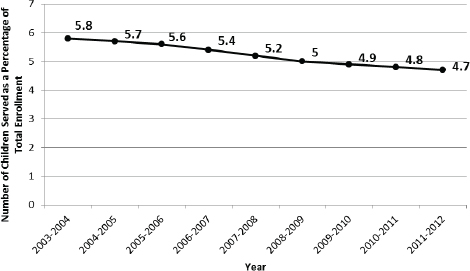
FIGURE 16-4 Children with LD, ages 3–21 served under IDEA, as a percentage of all school children, 2003–2012.
SOURCE: NCES, n.d.
TABLE 16-1 Percentage of Children, Ages 3–17, Reported to Have Ever Been Diagnosed by a School or a Health Professional as Having a Learning Disability
| 1997 | 1998 | 1999 | 2000 | 2001 | 2002 | 2003 | |
| Total | 7.8 | 7.5 | 7.2 | 7.9 | 7.7 | 8.1 | 7.5 |
| Gender | |||||||
| Male | 10.1 | 9.5 | 9.8 | 9.9 | 9.7 | 10.1 | 9.2 |
| Female | 5.3 | 5.4 | 4.5 | 5.7 | 5.5 | 6.0 | 5.6 |
| Race/Hispanic origin | |||||||
| Non-Hispanic white | 8.5 | 7.5 | 7.6 | 8.3 | 7.8 | 8.5 | 8.0 |
| Non-Hispanic black | 7.6 | 9.7 | 7.7 | 9.2 | 9.0 | 10.7 | 7.6 |
| Hispanic | 5.7 | 6.1 | 5.5 | 6.1 | 6.5 | 5.8 | 6.1 |
| Non-Hispanic other | 4.1 | 4.1 | 5.1 | 4.2 | 5.3 | 3.2 | 4.8 |
| Age group | |||||||
| Ages 3–4 | 1.8 | 2.7 | 1.1 | 2.3 | 1.5 | 1.0 | 2.0 |
| Ages 5–11 | 7.2 | 6.6 | 6.9 | 7.4 | 7.4 | 8.0 | 7.1 |
| Ages 12–17 | 10.5 | 10.2 | 9.6 | 10.3 | 10.0 | 10.5 | 9.6 |
| Poverty status | |||||||
| At or above poverty | — | 6.9 | 6.8 | 8.0 | 7.3 | 7.5 | 7.6 |
| Below poverty | — | 11.4 | 11.9 | 10.7 | 12.6 | 14.1 | 9.7 |
NOTE: Reproduced with permission.
SOURCE: Child Trends Databank, 2014.
With the exception of a recent increase in the percent of all 3- to 4-year-olds reported to have LD, there are no clear gender, race/ethnicity, age, or economic status trends during this 17-year period.
TRENDS IN THE RATES OF LEARNING DISABILITY AMONG SSI AND MEDICAID POPULATIONS
This section of the report presents data on trends in the rates of LD in the SSI program for children from 2004 to 2014 and in Medicaid from 2001 to 2010.
SSI
Within the SSI program for children with mental disorders, LD is the basis for a relatively small but still substantial number of allowances, determinations, and recipients for SSI benefits.
Table 16-2 provides the SSI administrative data on LD among children. Column 1 shows a decreasing number of child allowances made on the basis of LD. Column 2 shows little variation in the total number of child
| 2004 | 2005 | 2006 | 2007 | 2008 | 2009 | 2010 | 2011 | 2012 | 2013 |
| 8.0 | 6.9 | 7.8 | 7.5 | 8.1 | 8.2 | 7.9 | 7.5 | 8.0 | 7.5 |
| 9.5 | 8.7 | 9.6 | 9.6 | 10.0 | 10.6 | 9.3 | 9.2 | 10.0 | 9.0 |
| 6.4 | 5.1 | 5.9 | 5.3 | 6.1 | 5.7 | 6.4 | 5.7 | 6.0 | 5.9 |
| 8.5 | 7.0 | 8.6 | 8.0 | 9.1 | 8.7 | 8.1 | 8.1 | 8.7 | 7.5 |
| 9.6 | 8.4 | 7.9 | 7.7 | 9.1 | 9.6 | 10.3 | 8.5 | 8.2 | 9.5 |
| 5.6 | 7.0 | 6.3 | 6.7 | 5.8 | 7.1 | 6.5 | 6.3 | 7.0 | 7.2 |
| 4.8 | 2.5 | 2.7 | 2.6 | 4.3 | 3.9 | 4.2 | 4.5 | 5.2 | 3.2 |
| 2.5 | 1.5 | 2.1 | 2.1 | 2.3 | 2.8 | 3.2 | 2.6 | 2.4 | 3.2 |
| 7.4 | 6.5 | 7.2 | 6.7 | 8.8 | 7.6 | 8.0 | 7.0 | 8.1 | 7.8 |
| 10.5 | 9.2 | 10.2 | 10.2 | 9.4 | 10.8 | 9.3 | 9.8 | 9.7 | 9.3 |
| 7.9 | 6.5 | 7.6 | 7.4 | 7.9 | 7.7 | 7.1 | 6.8 | 7.4 | 6.4 |
| 11.3 | 11.0 | 10.7 | 9.3 | 12.4 | 11.4 | 12.3 | 9.8 | 11.8 | 11.9 |
recipients who received SSI benefits on the basis of LD, particularly if 2004 data are excluded. Column 3 shows the estimated total number of children in households with incomes under 200 percent of the federal poverty level (FPL) for each year. To control for the changes in the magnitude of child poverty, as displayed in column 3, columns 4 and 5 show the rates of allowances and recipients as a percentage of the number of children in households under 200 percent FPL. Column 4 shows the percentage of children in households under 200 percent FPL who were allowed benefits for LD, meaning they were found to be disabled due to a diagnosis of LD. Column 5 shows the percentage of children in households under 200 percent FPL who were recipients of SSI payments for LD in December of each year. Figure 16-5 plots the percentages from columns 4 and 5 along with the 10-year average of the percentages of allowances and recipients for LD as a visual reference point.
As shown in Figure 16-5, over the 10-year period from 2004 to 2013 the proportion of children under 200 percent FPL who were child SSI LD recipients increased from 2004 through 2007, decreased through 2011, then increased slightly through 2013. No overall trend is noted. Over the same time period, the rate of child SSI LD allowances gradually and
TABLE 16-2 SSI Child Initial Allowances and Recipient Numbers for LD
| Year | 1 | 2 | 3 | 4 | 5 |
| # of Child SSI Allowances for LD | # of Child SSI Recipients for LD | # of Children in Households Under 200% FPL | % of Children Under 200% FPL Allowed SSI Benefits for LD | % of Children Under 200% FPL Who Are Recipients of SSI Benefits for LD | |
| 2004 | 6,940 | 33,833 | 28,753,000 | 0.024% | 0.118% |
| 2005 | 6,720 | 37,118 | 28,539,000 | 0.023% | 0.130% |
| 2006 | 5,811 | 38,934 | 28,757,000 | 0.020% | 0.135% |
| 2007 | 5,230 | 39,597 | 28,999,000 | 0.018% | 0.137% |
| 2008 | 5,211 | 39,619 | 30,064,000 | 0.017% | 0.132% |
| 2009 | 5,428 | 39,868 | 31,505,000 | 0.017% | 0.127% |
| 2010 | 5,681 | 40,278 | 32,254,000 | 0.018% | 0.125% |
| 2011 | 5,590 | 40,533 | 32,678,000 | 0.017% | 0.124% |
| 2012 | 5,061 | 40,924 | 32,269,000 | 0.016% | 0.127% |
| 2013 | 4,513 | 40,461 | 31,364,000 | 0.014% | 0.129% |
NOTE: The Current Population Survey table creator was used to generate numbers of children below 200 percent of the federal poverty level. Parameters used to generate the numbers include get count of: persons in poverty universe (everyone except unrelated individuals under 15); years: 2004 to 2013; Census 2010 weights; row variable: age; column variable: income-to-poverty ratio; and customized formatting: income-to-poverty ratio percent cutoff of 200 percent.
SOURCES: U.S. Census Bureau, 2015; unpublished data set provided by the SSA.
continuously decreased. The rate of child LD allowances among children in households under 200 percent FPL decreased by 40.4 percent, from 0.024 percent in 2004 to 0.014 percent in 2013. Despite these declining annual allowance rates, the total number of recipients each year increased throughout this period, from 0.118 percent in 2004 to 0.129 percent in 2013, an increase of 9.6 percent, although if the 2004 number were excluded, the 9-year change would be downward.
Medicaid
Table 16-3 shows the percentage of children who were diagnosed with LD in two different groups of Medicaid enrollees for each year from 2001 to 2010. Column 1 shows the percentage of all Medicaid enrollees who had a diagnosis of LD, by year. Column 2 shows the percentage of LD diagnoses among the smaller subpopulation of Medicaid enrollees who
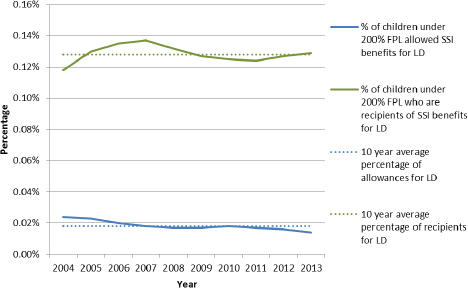
FIGURE 16-5 Percentages of SSI child initial allowances and recipients for LD under 200 percent FPL.
NOTE: The Current Population Survey table creator was used to generate numbers of children below 200 percent of the federal poverty level. Parameters used to generate the numbers include get count of: persons in poverty universe (everyone except unrelated individuals under 15); years: 2004 to 2013; Census 2010 weights; row variable: age; column variable: income-to-poverty ratio; and customized formatting: income-to-poverty ratio percent cutoff of 200 percent.
SOURCES: U.S. Census Bureau, 2015; unpublished data set provided by the SSA.
were eligible to be enrolled in Medicaid on the basis of their eligibility to receive SSI benefits.
The rate of LD diagnoses among all child Medicaid enrollees stayed essentially unchanged between 2001 and 2010 (see Figure 16-6). However, during the same period the proportion of child SSI-eligible Medicaid enrollees with a diagnosis of LD increased from 5.6 to 6.8 percent (an increase of 21.4 percent), with most of the increase occurring between 2008 and 2010.
For the 6-year period of overlap between the Medicaid and SSI administrative data sets, from 2004 to 2010, the rate of LD diagnoses among all Medicaid-enrolled children increased by 20 percent, while the rate of LD diagnoses among SSI-eligible Medicaid-enrolled children increased by 15.25 percent. There was a 9.6 percent increase in the rate of SSI recipients for LD among children in households under 200 percent FPL.
TABLE 16-3 Percentage of Child Medicaid Enrollees and SSI Medicaid Enrollees Diagnosed with LD
| Year | 1 | 2 |
| % of All Child Medicaid Enrollees with LD Diagnosis | % of Child SSI Medicaid Enrollee Subpopulation with LD Diagnosis | |
| 2001 | 1.20% | 5.60% |
| 2002 | 1.10% | 5.70% |
| 2003 | 1.10% | 5.80% |
| 2004 | 1.00% | 5.90% |
| 2005 | 1.00% | 5.90% |
| 2006 | 1.10% | 6.00% |
| 2007 | 1.10% | 5.70% |
| 2008 | 1.10% | 5.80% |
| 2009 | 1.10% | 6.00% |
| 2010 | 1.20% | 6.80% |
SOURCE: MAX data.
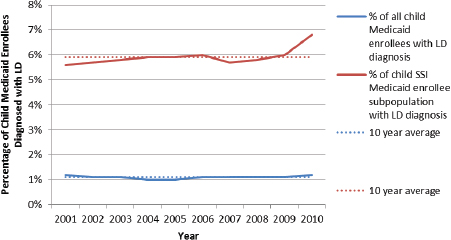
FIGURE 16-6 Percentage of child Medicaid enrollees and SSI Medicaid enrollees diagnosed with LD.
SOURCE: MAX data.
DISCUSSION
The trends in the estimated prevalence of LD among children vary depending on the population studied and on the ways that cases of LD are identified. Overall, the trends in the SSI program are generally consistent with trends generated from surveys of the general population, special education service use, or diagnoses among children in the Medicaid population.
The estimates of prevalence from the population surveys suggest no clear trend, either increasing or decreasing, from 2004 to 2013. The NHIS results showed no clear trend, with the prevalence of LD fluctuating between 6.9 and 8.2 percent, with no increase or decrease between 2004 and 2013, of the percentage of children of ages 3–17 reported to have ever been diagnosed by a school or health professional as having a learning disability. IDEA special education service utilization data showed that the rates of special education use for LD decreased from 5.8 percent in 2004 to 4.7 percent in 2011–2012, a decrease of 18.96 percent. The results of studies that show difference by race and ethnicity must be cautiously interpreted, since there is evidence of diagnostic and test bias for children with LD, even after taking into account the effects of socioeconomic status (Coutinho et al., 2002; Jencks and Phillips, 1998).
The SSI data from 2004 to 2012 indicate that a gradually decreasing percentage of children under 200 percent FPL are being allowed SSI disability benefits for LD. Over the same time period, the percentage of children under 200 percent FPL who were recipients of SSI benefits for LD fluctuated, showing an increase from 2004 to 2007, a decrease from 2007 to 2011, and then another increase from 2011 to 2013; over the 10-year period the total increase was 0.011 percent.
The trends in the rate of LD diagnoses among all child Medicaid enrollees from 2001 to 2010 remained flat. The trends in the rate of LD diagnoses among children enrolled in Medicaid based on SSI eligibility also remained flat from 2004 to 2009; however, a marked increase in the rates of diagnoses occurred in 2010. It is not clear why this increase was observed.
In 2012, there were approximately 32 million children under age 18 living at or below 200 percent of the federal poverty level. Of these, approximately 21 million were of school age (ages 6–17 years). Recent U.S. prevalence data suggest that approximately 4 percent of the child population were diagnosed with a moderate or severe learning disorder (NSCH, 2012a). This suggests that there are approximately 840,000 school-aged children below 200 percent FPL with a severe learning disability, an estimate that is likely to be quite conservative. By contrast, in 2012, 40,924 children received SSI benefits with a diagnosis of learning disability, or approximately 5 percent, which was well below the estimated eligible number. Figure 16-7 illustrates these relationships.
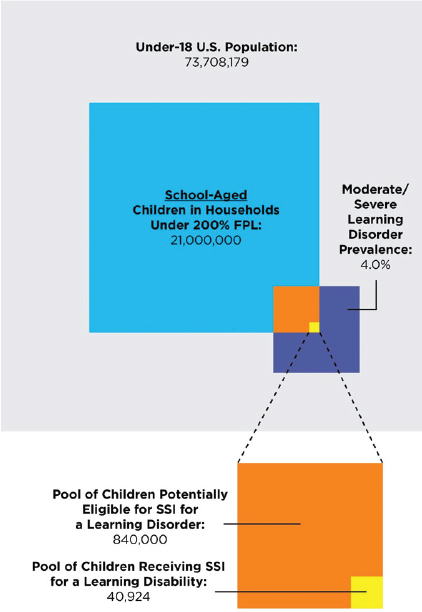
FIGURE 16-7 Children potentially eligible for SSI for LD versus children receiving SSI for LD in 2013, according to the NSCH.
NOTE: The Current Population Survey table creator was used to generate numbers of children below 200 percent of the federal poverty level. Parameters used to generate the numbers include get count of: persons in poverty universe (everyone except unrelated individuals under 15); years: 2004 to 2013; Census 2010 weights; row variable: age; column variable: income-to-poverty ratio; and customized formatting: income-to-poverty ratio percent cutoff of 200 percent.
SOURCES: U.S. Census Bureau, 2014, 2015; NSCH, 2012a; unpublished data set provided by the SSA.
FINDINGS
- Prevalence estimates for LD in the general population range between 5 and 9 percent.
- Prevalence in the general population is stable, but from 2003 to 2012 the number of children receiving special education services based on an LD diagnosis decreased.
- Within the SSI program, trends in both the number of LD allowances and the rate of LD allowances in children in low-income households is decreasing. From 2004 to 2013, the number of the SSI recipients for LD was stable.
- Among children enrolled in Medicaid on the basis of SSI eligibility, the rate of children with an LD diagnosis appears to be increasing. Among all children enrolled in Medicaid, there does not appear to be an increase in the rates of LD diagnoses.
CONCLUSIONS
- Rough estimates of the number of children in low-income households with moderate to severe ID suggest that less than 24 percent of children who are likely eligible for SSI benefits due to ID are recipients of these benefits.
- There is no evidence that the trends observed in the proportion of children receiving SSI benefits for LD are inconsistent with the prevalence trends observed in the general or Medicaid populations.
REFERENCES
Child Trends Databank. 2014. Learning disabilities. www.childtrends.org/?indicators=learning-disabilities (accessed August 4, 2015).
Cortiella, C., and S. H. Horowitz. 2014. The state of learning disabilities: Facts, trends, and emerging issues, 3rd edition. New York: National Center for Learning Disabilities. http://www.ncld.org/wp-content/uploads/2014/11/2014-State-of-LD.pdf (accessed July 16, 2015).
Coutinho, M. J., D. P. Oswald, and A. M. Best. 2002. The influence of sociodemographics and gender on the disproportionate identification of minority students as having learning disabilities. Remedial and Special Education 23(1):49–59.
Dhuey, E., and S. Lipscomb. 2009. Disabled or young?: Relative age and special education diagnoses in schools. Economics of Educational Review 29:857–872.
Halfon, N., A. Houtrow, K. Larson, and P. W. Newacheck. 2012. The changing landscape of disability in childhood. Future of Children 22(1):13–42.
Jencks, C. and M. Phillips. 1998. The black-white test scope gap: Why it persists and what can be done. The Brookings Review 24–27.
Livermore, G., D. Whalen, S. Prenovitz, R. Aggarwal, and M. Bardos. 2011. Disability data in national surveys. Washington, DC: Office of Disability, Aging, and Long-Term Care Policy, U.S. Department of Health and Human Services.
NCES (National Center for Education Statistics). n.d. Table 204.30: Children 3 to 21 years old served under Individuals with Disabilities Education Act (IDEA), Part B, by type of disability: Selected years, 1976–77 through 2011–12. Digest of Education Statistics. http://nces.ed.gov/programs/digest/d13/tables/dt13_204.30.asp (accessed July 16, 2015).
NSCH (National Survey of Children’s Health). 2007a. Data query from the child and adolescent health measurement initiative. http://childhealthdata.org/browse/survey/results?q=1219 (accessed August 4, 2015).
NSCH. 2007b. Data query from the child and adolescent health measurement initiative. http://childhealthdata.org/browse/survey/results?q=1235 (accessed August 4, 2015).
NSCH. 2012a. Data query from the child and adolescent health measurement initiative. http://childhealthdata.org/browse/survey/results?q=2542&r=1 (accessed August 4, 2015).
NSCH. 2012b. Data query from the child and adolescent health measurement initiative. http://childhealthdata.org/browse/survey/results?q=2542&r=1&g=456 (accessed August 4, 2015).
NSCH. 2012c. Data query from the child and adolescent health measurement initiative. http://childhealthdata.org/browse/survey/results?q=2542&r=1&g=458 (accessed August 4, 2015).
U.S. Census Bureau. 2014. Total population by child and adult populations. http://datacenter.kidscount.org/data/tables/99-total-population-by-child-and-adult-populations?loc=1&loct=1#detailed/1/any/false/35,18,17,16,15/39,41/416,417 (accessed November 14, 2014).
U.S. Census Bureau. 2015. CPS table creator. www.census.gov/cps/data/cpstablecreator.html (accessed July 13, 2015).














